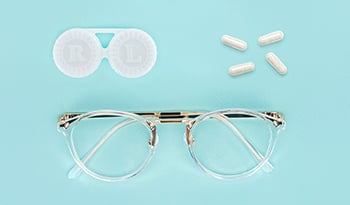A Quick Guide to Lutein and Zeaxanthin
DISCLAIMER:This blog does not intend to provide diagnosis...

Lutein and zeaxanthin are yellow-orange plant carotenoid pigments known as xanthophylls that are critically important to eye health, specifically the lens of the eye and the macula lutea. They are found in such foods as green leafy vegetables, especially kale and spinach. Egg yolk is another rich source.
Higher intake and supplementation with lutein and zeaxanthin improves the function of the macula lutea, the yellow part of the retina needed for sharp, central vision. The macula lutea is yellow because of its ability to concentrate lutein and zeaxanthin. A better functioning macula lutea with higher levels of these yellow pigments is what allows us see things with the greatest degree of focus. Lutein and zeaxanthin help protect the macula lutea against oxidative damage. Low dietary levels of these carotenoids lead to macular degeneration, the major cause of severe vision loss seen with aging.
Lutein and Zeaxanthin Protect the Macula Lutea
Low levels of lutein and zeaxanthin within the macula lutea represent a major risk factor for the disease. In fact, people with macular degeneration have 35 to 40 percent less lutein in the macula than people without macular degeneration. In addition, research shows that supplementing with lutein and zeaxanthin not only helps prevent macular degeneration, but it can also actually improve visual function in people who already have it. Specifically, in subjects with macular degeneration, lutein and zeaxanthin supplementation improves glare recovery, contrast sensitivity, and visual acuity.
The benefits of supplementation with lutein and zeaxanthin has considerable scientific support. In a detailed analysis of 20 double-blind, placebo-controlled trials supplementation with lutein and/or zeaxanthin at dosages ranging from 10 to 20 mg and 500 mcg to 2,000 mcg, respectively showed a clear dose-response in increasing the density of pigmentation in the macula. With greater levels of these two critical pigments, improvements in the ability to bring objects into focus are observed in the test subjects receiving lutein and zeaxanthin. For example, in the Lutein Antioxidant Supplementation Trial, a 12-month double-blind study, patients receiving lutein (10 mg) and zeaxanthin (500 mcg) showed improvements in the density of pigment in the macula that corresponded to the degree of improvement in visual acuity and contrast sensitivity. Patients who received the placebo, however, showed no significant changes in any of the measured findings.
Lutein and Zeaxanthin Also Protect Against Cataracts
Lutein and zeaxanthin are also important in preventing cataracts and improving visual function in people with existing cataracts. Like the macula lutea, the human lens concentrates lutein and zeaxanthin. In fact, these are the only carotenoids found in the human lens. Seven large clinical trials have shown that a higher lutein intake is associated with decreased likelihood of needing cataract surgery. In addition, protecting against developing cataracts, lutein can also help improve visual function in people who have them.
Available Forms:
Lutein and zeaxanthin supplements are either derived from the marigold flower or manufactured synthetically. Lutein is most often available in soft-gelatin capsules to improve absorption, but may also be found in hard-gelatin capsules and tablets. Naturally-derived lutein and zeaxanthin at a ratio of 10 mg and 500 mcg, respectively, delivered in a soft-gelatin capsule is the preferred form.
Usual Dosage:
To boost levels in patients with macular degeneration or cataracts, take 20 mg lutein and 1,000 mcg zeaxanthin daily for at least 3 months before settling into this daily dosage of 10 mg of lutein and 500 mcg zeaxanthin. For prevention, take 10 mg of lutein and 500 mcg zeaxanthin daily.
Side Effects:
None known.
Drug Interactions:
None known.
Food Interactions:
Lutein is most often recommended to be taken with food to possibly improve absorption.

 By Dr. Michael Murray, N.D.
By Dr. Michael Murray, N.D. 


